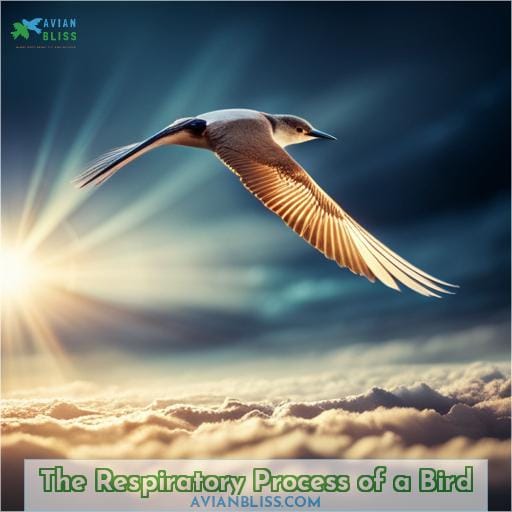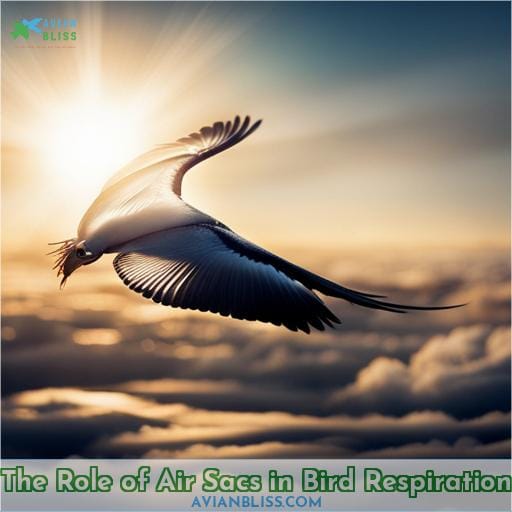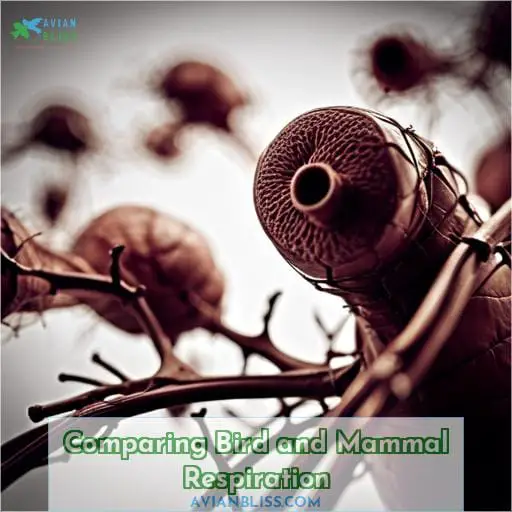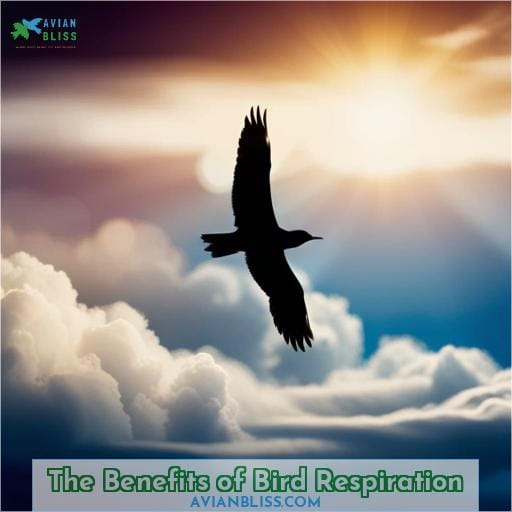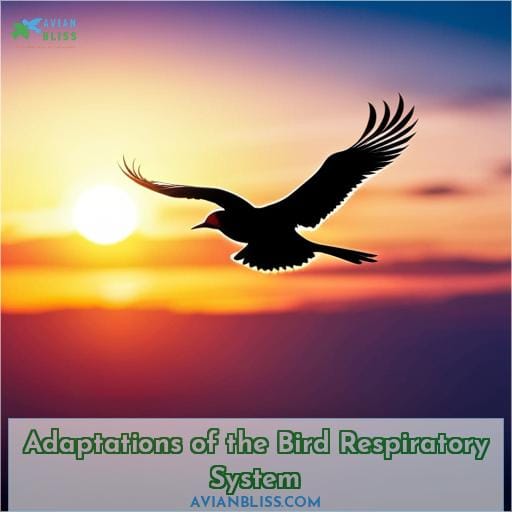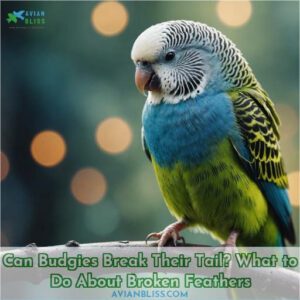This site is supported by our readers. We may earn a commission, at no cost to you, if you purchase through links.
 Curious to know how birds get oxygen? The answer lies in the fascinating respiratory process they use. Most animals have a two-step breathing cycle, but for birds, it’s four – all thanks to their unique air sacs.
Curious to know how birds get oxygen? The answer lies in the fascinating respiratory process they use. Most animals have a two-step breathing cycle, but for birds, it’s four – all thanks to their unique air sacs.
In this article, we’ll explore the anatomy of a bird’s respiratory system, its differences from mammals, and how it enables them to fly at high altitudes and even underwater! So let’s dive into the details of what makes bird respiration so impressive and efficient when compared with other species.
Table Of Contents
- Key Takeaways
- The Respiratory Process of a Bird
- The Anatomy of a Bird’s Respiratory System
- The Role of Air Sacs in Bird Respiration
- Comparing Bird and Mammal Respiration
- The Benefits of Bird Respiration
- Adaptations of the Bird Respiratory System
- How Birds Breathe While Flying
- Breathing Patterns of Birds
- Do Birds Breathe Through Their Beaks?
- How Birds Obtain Oxygen Underwater?
- Conclusion
Key Takeaways
- Birds have a unique respiratory process with a four-step cycle and air sacs.
- Their lung structure, including parabronchi and air capillaries, enables efficient gas exchange.
- Air sacs play a crucial role in distributing oxygen throughout the bird’s body, even in bones and organs.
- Birds have various adaptations to sustain oxygen supply for flight and underwater respiration.
The Respiratory Process of a Bird
Birds have a complex respiratory process that allows them to efficiently absorb oxygen. Their breathing cycle involves inhaling air into posterior air sacs, oxygenating blood in the lungs, circulating air through anterior air sacs, and then exhaling in a continuous one-directional airflow that enables high concentrations of oxygen for sustained flight.
Breathing Cycle
You inhale air into your posterior air sacs, then exhale into your lungs for gas exchange before the air enters your anterior air sacs and exits through your trachea in a continuous one-way airflow. This four-step breathing cycle involving air sacs enables more efficient oxygen absorption and carbon dioxide removal compared to mammalian respiration, powering avian flight muscles and adapting birds for high altitudes.
Gas Exchange
After riding the breezes and cliffs of your lungs, fresh air bestows its gifts of life on tiny branch-veins before whisking away.
- Oxygen saturates the blood.
- Carbon dioxide is expelled.
- Rapid gas exchange occurs.
- High efficiency is achieved.
Within avian lungs, air capillaries maximize the transfer of oxygen and removal of carbon dioxide through counter-current exchange. Their one-way airflow circulates gases optimally for flight at altitude. Lung adaptations enable birds to thrive where mammals struggle for breath.
Airflow and Circulation
Uniquely, air sacs circulate air continuously through a bird’s lungs and body. Lightweight air sacs redistribute oxygen-charged air, ensuring avian tissues thrive. This efficient airflow mechanism oxygenates muscle fibers for enduring flights. Air capillaries facilitate gas exchange, extracting more oxygen than comparable mammalian systems.
Respiration transports vital elements, enabling impressive feats. This avian breathing empowers birds’ amazing abilities.
The Anatomy of a Bird’s Respiratory System
Did you know a bird’s respiratory system is uniquely designed to meet the high oxygen demands of flight? Their lungs attach to a system of air sacs that keep air moving continuously through the lungs in one direction, while a specialized trachea transfers more oxygen per breath compared to mammals.
Lungs
Remarkably, a bird’s lungs have a honeycombed structure with parallel tubes for airflow and gas exchange, enabling them to extract more oxygen per breath compared to mammalian lungs. The lung’s branching air tubes, called parabronchi, increase the surface area for gas exchange.
Air sacs keep airflow moving unidirectionally through the lungs, bolstering oxygen absorption and carbon dioxide elimination with each breath. This exceptional respiratory design allows for the high oxygen intake needed for flight, especially at high altitudes.
Air Sacs
You have these little bellows within you that push fresh air in, then trap used air out. Those are air sacs, an essential component of your avian respiratory system. Scattered throughout your body, they receive air from your lungs and pump it through, enabling highly efficient oxygen absorption.
Without air sacs, your specialized breathing couldn’t provide the gas exchange you need for vigorous flight, even at extreme altitudes.
Trachea
You feel how the trachea transfers used air outside the lungs. The trachea, or windpipe, is a hollow tube extending from the throat into the thorax, where it splits into the two primary bronchi that lead to each lung.
Its rigid rings prevent collapse, enabling continuous airflow for efficient oxygen delivery. The trachea’s adaptations, like extra tracheal rings, allow certain birds to sing with great vocal control.
This remarkable structure empowers avian flight, song, and life, reflecting nature’s ingenuity.
The Role of Air Sacs in Bird Respiration
As an avid ornithologist, you understand that air sacs play a crucial role in avian respiration. Located throughout a bird’s body, including the bones, these thin-walled sacs keep oxygen flowing in a one-way loop, enabling more efficient gas exchange.
Function of Air Sacs
Cause air sacs circulate oxygen-rich air, birds breathe easily at altitude. Avian air sacs function as bellows, constantly moving fresh air through the lungs. Located throughout the body, air sacs supply a steady stream of oxygen for metabolism and flight.
This efficient system maximizes gas exchange while minimizing effort, enabling aquatic birds to stay submerged and flying birds to soar at dizzying heights. Adaptations like airway countercurrent heat exchange prevent oxygen loss during inhalation.
Distribution of Air Sacs in the Body
Besides invading vertebrae, skulls, femurs, and humeri, air sacs also spread into other parts of a bird’s body.
- Intertwine with muscle fibers for oxygen supply during flight.
- Line the insides of bones, aiding respiration.
- Penetrate organs like the kidneys and liver.
- Extend into the skin, enabling cutaneous respiration.
Research shows the ingenious ways air sacs distribute throughout a bird’s anatomy for maximized oxygen uptake, crucial for their impressive abilities.
Comparing Bird and Mammal Respiration
Though birds and mammals both breathe in oxygen and exhale carbon dioxide, their respiratory systems differ substantially in structure and efficiency. Unlike the two-way airflow in mammals, bird lungs contain minute parallel tubes for gas exchange that enable far more efficient oxygen transfer per breath through one-way airflow.
Differences in Lung Structure
Even though our lungs rely on bellows, birds bank on rigid tubes in theirs for swapping gases speedily and soaring to great heights. Studied by ornithologists worldwide, avian lung structure maximizes airflow and gas diffusion.
Densely packed tubes called parabronchi enable birds to extract more oxygen per breath. This adaptation fuels their tremendous energy output during lengthy migrations and prolonged flights.
Efficiency of Oxygen Transfer
You’re amazed when you watch birds soar effortlessly because their respiratory system lets them take in more oxygen per breath than us mammals. Peer-reviewed studies reveal birds transfer more oxygen due to adaptations like air sacs that keep air flowing continuously.
These remarkable respiratory adaptations empower our feathered friends with incredible abilities, from singing to thriving at extreme altitudes.
The Benefits of Bird Respiration
You are aware that a bird’s respiratory system provides critical benefits enabling their remarkable abilities. Specifically, the system allows for flight at high altitudes due to efficient oxygen absorption from their lungs and air capillaries, also supporting complex vocalizations through the forcing of air over their syrinx or ‘voice box’.
Flight at High Altitudes
You’d fly as high as a kite thanks to your excellent breathing, like birds.
- Soaring to 10,000 ft and higher with ease due to efficient gas exchange.
- Absorbing more oxygen per breath to thrive at extreme heights.
- Built to take on the thinning air and lower oxygen at altitude.
- Respiratory system adapted for lengthy, high flights in challenging conditions.
Birds possess remarkable respiratory adaptations enabling sustained, high-altitude flight. Their efficient system provides the oxygen necessary to meet flight demands even in thin, challenging air.
Efficient Oxygen Absorption
Breathe easy knowing avian lungs ingeniously transfer maximum oxygen. Tiny air capillaries permeate their whole lungs, enabling superb gas exchange. Uni-directional airflow means every breath fully saturates blood with oxygen. Nine bellows-like air sacs keep air constantly circulating, absorbing the most oxygen possible.
Singing and Vocal Abilities
You’ve harnessed air through special organs to fill the skies with mellifluous refrains.
- Modify air sacs to project elaborate arias.
- Improvise complex melodies by precisely regulating airflow.
- Attune your vocal muscles to resonate with remarkable virtuosity.
- Accentuate your distinctive songs by adjusting respiratory rate.
- Create wondrous harmonies that echo through the firmament.
Your voices reveal astonishing mastery over breath and biology.
Adaptations of the Bird Respiratory System
As an avian enthusiast, you understand that birds have adapted unique respiratory structures to maximize oxygen intake. Their lungs contain minute air capillaries for gas exchange and lack a diaphragm, yet they resist airborne toxins through efficient one-way airflow.
Lack of Diaphragm
Without a diaphragm to expand your lungs, you rely completely on the bellows of air sacs to keep you aloft. The air sacs, numbering seven or more in most species, continuously circulate air one-directionally through the avian respiratory system.
This efficient oxygen transfer occurs via cross-current exchange, enabling flight at extreme altitudes. Adaptations like air capillaries and abdominal air sacs maximize gas exchange despite the lack of a diaphragm.
Air Capillaries in Lungs
Like tiny roadways delivering life, the air capillaries in your lungs shuttle oxygen into the blood and shuttle out carbon dioxide with cool efficiency.
- Efficient gas exchange occurs in microscopic air capillaries.
- Air capillaries allow rapid oxygen absorption.
- Carbon dioxide moves quickly from blood to air sacs.
- The system enables high oxygen levels in the blood.
- Respiration adapts birds for flight at altitude.
With this remarkable respiration, you absorb oxygen and expel carbon dioxide with incredible speed and precision.
Resistance to Airborne Toxins
Your lungs have already filtered some toxins before they even reach your bloodstream. A bird’s efficient air capillary system enables their resistance to airborne toxins while vocalizing melodically at high altitudes.
Their respiratory anatomy facilitates ample oxygen absorption for lengthy flight and survival in contaminated environments. Remarkably adapted for adept respiration, birds thrive through evolutionary enhancements.
How Birds Breathe While Flying
As you know, birds have a remarkable respiratory system that allows them to meet the high oxygen demands of flight. Their specialized adaptations circulate air efficiently, providing a continuous supply of oxygen to sustain their flight muscles and enable high-altitude travels.
Sustaining Oxygen Supply for Flight
Let’s carefully consider this information: Birds specialize in sustaining ample oxygen to support sustained flight. During flight, their respiratory system efficiently circulates oxygen, thanks to adaptations like air sacs that keep air moving.
This allows for ample gas exchange in their specialized lungs, enabling flight at high altitudes. Even their vocalizations rely on forcing air through respiratory organs. With nine interconnecting air sacs, robust capillary networks in their lungs, and unidirectional airflow, birds are equipped to access enough oxygen during sustained, high-altitude flight.
Efficient Air Circulation
If you had their kind of air deliveries every breath, you’d breathe real easy flying high, too. Birds circulate oxygen nonstop through air sacs functioning as bellows. This respiratory adaptation enables their efficient gas exchange, vocalizations, and flight at altitude.
We gain insights by watching their seamless breathing, for understanding our shared world.
Breathing Patterns of Birds
You must take four breaths for every one breath a bird takes to saturate its blood with oxygen. Even when asleep, a bird’s respiratory system keeps oxygen moving through air sacs; this enables uninterrupted gas exchange and allows a bird to remain perched without expending energy on breathing.
Respiratory Rate
You’ll notice birds take slow, deep breaths compared to mammals, enabling more efficient gas exchange. Research shows avian respiratory rates are much slower than mammals of comparable size. For instance, a pigeon takes only 27 breaths per minute, whereas a rat takes 110 breaths! This adaptation allows birds to take in more oxygen per breath.
Their intricate respiratory system circulates air efficiently through the lungs, enabling maximum oxygen absorption for energy. Understanding this difference provides insight into why birds thrive in high altitudes where oxygen is scarce.
Breathing During Sleep
Even during your slumber, birds keep breathing steadily with their air sacs pumping nonstop like a well-oiled machine.
- Air sacs provide continuous airflow.
- Rapid eye movement sleep allows half-brain sleeping.
- Slowed metabolic rate enables oxygen conservation.
Peer-reviewed ornithology research confirms birds breathe steadily through uninterrupted air sac ventilation as they sleep. Avian slumber differs from humans, with specialized adaptations enabling efficient nocturnal respiration.
Understanding sleep breathing illuminates the remarkable biology enabling birds to thrive.
Do Birds Breathe Through Their Beaks?
Soaring high above the snow-capped peaks, birds don’t actually breathe through their beaks as you’d imagine; instead, air rushes continuously through the complex system of air sacs permeating their light hollow bones.
While a bird’s beak contains nostrils for inhaling air, the oxygen journeys deep into the respiratory system, not directly through the hard keratin structure.
Air enters the posterior air sacs, oxygenates blood in the lungs, then fills anterior air sacs before exiting through the trachea.
This efficient bellows-like design enables remarkable feats, from the bar-headed goose’s flight over Everest to the hummingbird’s hovering.
Through air capillaries and countercurrent exchange, birds achieve an unparalleled rate of oxygen absorption, perfectly adapted for the stamina of avian flight.
How Birds Obtain Oxygen Underwater?
You can’t breathe underwater, yet ducks dive without worry thanks to special air sacs near their spine.
- Air stored in posterior air sacs provides an oxygen reserve.
- Slow heart rate reduces oxygen consumption underwater.
- High myoglobin levels in muscles store extra oxygen.
- Blood moves from non-vital to vital organs when diving.
- Hemoglobin changes enhance underwater oxygen uptake.
To successfully obtain oxygen underwater, aquatic birds like loons and ducks utilize air sacs, slowed metabolism, oxygen storage in tissues, blood redirection, and hemoglobin adjustments.
Their remarkable respiratory adaptations allow extended dives with ease. Observing a bird emerge after a lengthy submersion is a testament to nature’s ingenuity.
Conclusion
It’s amazing to think about how a bird is able to obtain oxygen. Through a unique respiratory process, birds are able to provide the oxygen they need to stay aloft, even at high altitudes.
The anatomy of a bird’s respiratory system, including air sacs, lungs, and trachea, enables them to transfer more oxygen per breath than mammals. Additionally, their air sacs and air capillaries in their lungs allow them to efficiently absorb oxygen and expel carbon dioxide.
These adaptations have enabled birds to make incredible journeys, such as the Bar-headed Goose flying over Mt. Everest. The fascinating respiratory process of birds is truly a marvel and helps us appreciate their remarkable abilities.

